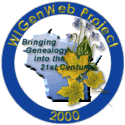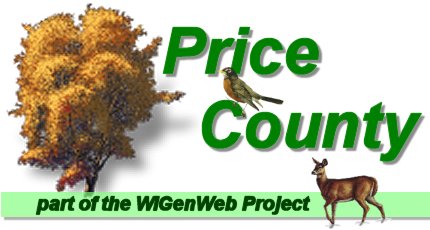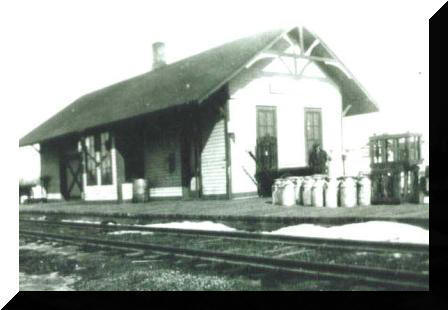|
|
|
|
Brantwood Francis
Palms was the first to purchase land in the area, buying it up as quickly as
it became available for purchase. According to some records, he purchased
some of the land for as little as $1.25 an acre while obtaining additional
lands at little or no cost under various Acts of Congress that made land
available to homesteaders and investors. Palms
owned the acreage for several years and after the railroad was built through
the area, Palms sold his lands including Town 35 North, Range 3 East to
brothers, William and Samuel Knox, for more than $8.00 per acre! William and
Samuel were loggers from Although
the Knox Brothers established a company town named Knox Mills, about five
miles south of what would later become Brantwood,
their logging and lumbering influenced the settlement of Brantwood
as well. 1890 - 1895 In 1890, Samuel Knox sold his share of the land to his brother, William. William began the expansion of his logging business by building a mill. The Minneapolis Sault Ste Marie and Atlantic Railroad (Soo Line) ran east and west about five miles north of William’s mill. He persuaded the railroad to build a spur down to his mill. The point where the spur joined the main railroad line was named Knox Junction. Although the exact date of changing the name from Knox Junction to Brantwood is unknown, when the post office was established there in January 1895 it was named Brantwood.
It was also in 1895 that William Knox began selling off the cut over land by enticing more immigrant settlers to the area with advertisements of land at bargain prices. E. H. Hobe was an agent for the railroad and was delegated the task of encouraging buyers for the land. Mr.
Hobe was also the Swedish-Norwegian Vice consulate and a realtor. These roles
put him in contact with Norwegians in Finnish immigrants were also targeted with advertisements
in several Finnish-American newspapers. The ads boasted of rich agricultural
farmlands at cheap prices ready for planting. Many immigrant families bought
acreage, sight-unseen, and began their journey to another new location
inspired by dreams and fueled by hope. Some
families traveled far distances in wagons that they had carefully packed with
their possessions. As they trekked from Some
families had friends or relatives already settled in the area that opened
their doors to the newcomers and while others stayed in one of the boarding
houses that William Knox owned and operated, a few settlers purchased land
parcels that included a house that they moved right into. As
the area became more populated, roads and schools were needed. Local taxes
had to be increased to pay for these additions and improvements. In an
attempt to exempt their lands from the tax increases, the big landowners,
including Knox, appealed to the county board. The result was a change in the
boundaries and the formation of new townships. In addition to the Towns of
Prentice, Hackett and Hill came the Town of In
1896, E. H. Hobe purchased the failing milltown of
Knox Mills from William Knox who had removed the sawmill
and the railroad spur. After Hobe built his own mill and had rails re-layed, he focused on selling acreage in the community of Brantwood. 1898 Under
Hobe’s influence, the communities of Brantwood
and Knox Mills rapidly grew simultaneously. By the spring of 1898, Brantwood had a lumberyard, warehouse, two hotels, a
boarding house, post office and Sunday school. In 1899, C. R. Sorenson
established a mercantile. 1900 Roads
were built between these two young communities that were booming with the
logging business. According to the 1900 US Federal Census, 411 men, women and
children were living in the Town of Working
from sunrise to sunset to establish their homes, farms or businesses, the
immigrant families complained little as they were finally working for
themselves (for the most part) and had finally found a place to call their
own. They took pride in their work and aimed to create a safe place to raise
their young families. For the Finnish immigrants, it was “Oma tupa,
oma lupa” an
old Finnish proverb meaning, “One’s own home, one’s own
master.” The communities of Knox Mills and Brantwood continued to grow and thrive for another twenty-some years until the logging industry started winding down. The economy slowly changed, families moved away and people grew old and died. With little to entice new residents to the area, Knox Mills eventually disappeared and the area was absorbed as part of the greater Brantwood community.
A comparison of the Platt Books from 1910 and 1957 shows the land ownership in the Town of Knox and how it changed.
Click on map for larger view
. The area also has a rich and extensive political history entwined in the Socialist and Communist movements of the era. More on this topic. Brantwood
eventually changed as well as it lost local businesses to the larger
surrounding communities. Many families still live in the area farming the
lands their grandfathers and great-grandfathers cleared. A few logging trucks
still transport second growth timber from the forests and several tree farms
supply Christmas trees to southern states. Today,
if you drive along any of the roads in the With
more than 100 years of history it is impossible to tell you everything about
the communities of Brantwood in this brief history.
Next time you are in the area, stop in and chat with the curators of Knox Creek
Farm and Knox Creek Heritage Center, both located near the intersection of
Return to Cities, Communities & Villages If you have any information
you would like to contribute, please contact the County Coordinator. |
||||||||||||||||||||||||||||||||||||
.
last edited
22 Apr 2012
|
Copyright Notice: All
files on this site are copyrighted by their creator. They may be linked to
but may not be reproduced on another site without specific permission from |



 Photo:
Photo:

